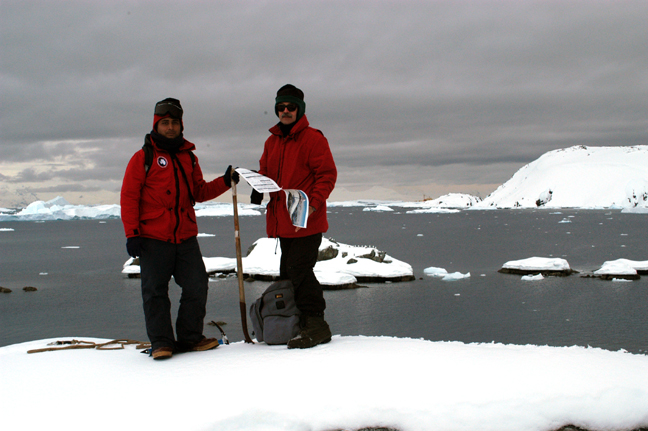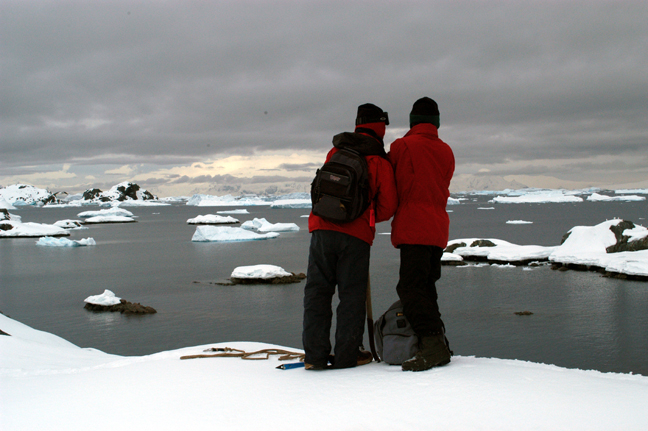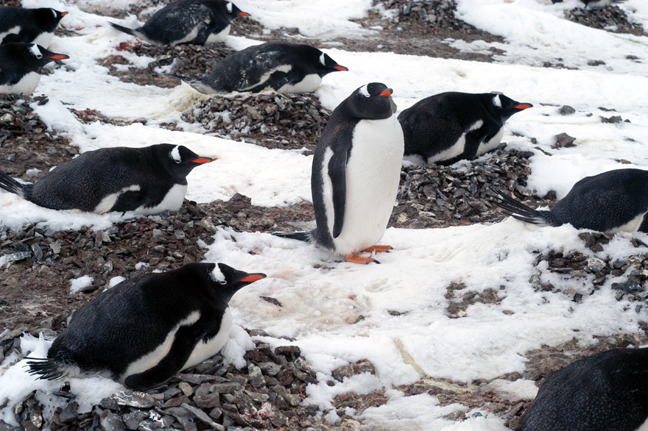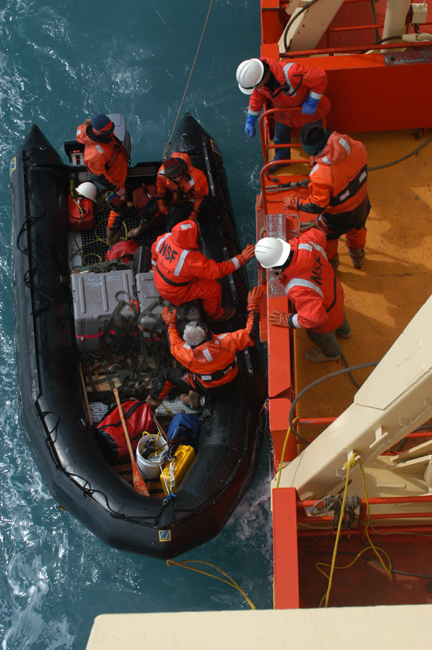In November 2002, UTIG researchers Fred Taylor, Cliff Frohlich, and graduate student Kris Gudipati, embarked on a NSF-funded project to study microplate motions in Antarctica using global positioning system (GPS) instruments. Neither Frohlich nor Gudipati had been to Antarctica previously. During the five-week field program aboard the research vessel Laurence M. Gould, Frohlich sent a series of letters and photographs to his friends and family describing what it was like to participate in this project. Published here, the letters and their belong to UTIG Senior Research Scientist Emeritus Cliff Frohlich.
From Cliff Frohlich, 28 November, 2002
Dear family & friends –
The day-before-yesterday we left the Drake Passage and arrived at Smith Island. Yesterday we installed GPS sites on Smith and Low Islands, and this morning we put one in at Spring point, on the Antarctic Peninsula. So thus it came to pass that on Thanksgiving morning, at the precise moment when y’all were putting your turkey in for the big meal, Cliff stepped out of a rubber boat and became the first Frohlich ever to set foot on the continent of Antarctica.
Now, all of you who have traveled know that it involves many dangers. The absolute worst is that fate will conspire so that you will miss out entirely on anything of interest, and thus you will have to admit to your friends that you never experienced any of the things that your trip is famous for. [‘You mean that it was foggy the entire week, and you never actually saw the Grand Canyon?’ ‘Wow! The whole glacier melted the month before you arrived, and so all you saw was some wet rocks?’ ‘Are you telling me that because it was unseasonably cold all the hula dancers were wearing down jackets?’]
For Antarctica, my quiet fear was that I would spend six weeks here and never see any penguins or icebergs. To my great relief, this has not turned out to be a problem. The first two GPS sites we visited were in the middle of penguin rookeries. And since we arrived at Smith Island there have been icebergs aplenty. Now I can go home, holding my head high. Before I explain about the GPS deployments, however, I must let y’all in on a little secret about Antarctica.
The secret is… [gather a little closer, ladies]… ANTARCTICA IS REALLY ALL ABOUT FASHION. Before you are allowed to visit shore; well, because I am married I will keep on my regular underwear. Over that I put on a pair of long underwear, a pair of fleece sweatpants, and a pair of nylon pants. For my upper body there are matching long sleeved undershirt, fleece jacket, (optional) down vest, and padded nylon parka. For my feet I was issued a pair wool socks and Sorel boots, which are regular high lace-up rubber boots with a thick felt liner, removable in case it gets wet. For my hands are regular thin wool knit gloves, and lined rubber gloves. For my head is a bakalava (or is that a dessert?) and goggles.
But wait, it is NSF policy that when you actually are in the zodiak, the small, motorized inflatable rubber boat that takes you to shore, you must wear a float suit of some kind. I have chosen a Helly Hanson suit, which is a cumbersome, full-body zip-up-to-the-chin contraption with boots built right in. This is horrific to put on; you must take off your sorel boots. And to the great delight of the crew this morning I accidentally managed to get it on backwords (‘I thought the feet looked funny.’). The thing is a pain but it is indeed warm; and apparently keeps you afloat and alive for at least a short while if you fall into the water. My feelings are; I will wear it if NSF says so but I hope I am never in a situation where I am glad to be wearing it.
Then, you must get into the zodiak from the deck of the ship. This is a basic problem in frequency-dependent filtering; since the zodiak is about 12 feet long it goes up and down with the little waves, but since the ship is perhaps 200 feet long it goes up and down only with the big waves. And of course, the little and big waves are completely out of synch. For the Helly-Hanson-rubber-glove- and-goggle-wearing-recent-knee-surgery challenged, zodiak entering and leaving can be tricky. I have had troubles a couple of times, but the good news is that although my pride has been wounded the experience left no marks on my person or water in my lungs. And, Skip Owen has not had to write any complicated reports. This is good. You always prefer to be on a cruise where the MPC (marine projects coordinator) writes only: ‘The scientific party, wearing their Helly-Hanson suits backwards, were deployed without incident, and completed their mission.’
And so we have, so far. The weather has been wonderfully cooperative. Smith Island is covered with snow and ice, and it took us an hour or so to chip it off the GPS site, once John stumbled across it. And, at Low Island there was a half-mile or so of hiking over which we had to move our gear, since the best zodiak landing point was a ways from the GPS site. We left John and Brenda to camp at Low Island for about five days, as it is one of the places where Brenda wants to take a close look. We will retrieve them and our own GPS equipment in a few days.


This morning at Spring Point the weather was absolutely gorgeous. Spring Point is a now-abandoned Chilean station (i.e., two small huts and a radio antenna) located in an iceberg-infested bay next to a glacier (turns out it didn’t melt the month before). The sea was like glass when we chugged away from the ship in the zodiak, and then the engine died, reassuringly. Turned out there was some water in the gas, and the marine techs, Toby and Jamie, got it going eventually as we drifted among the bergs. There was no wind as we shoveled off the piece of rock to find the GPS mark that Fred had installed there years ago. And we were back in the ship by noon, ready for Thanksgiving dinner.
But, dinner is another story…
Cliff




